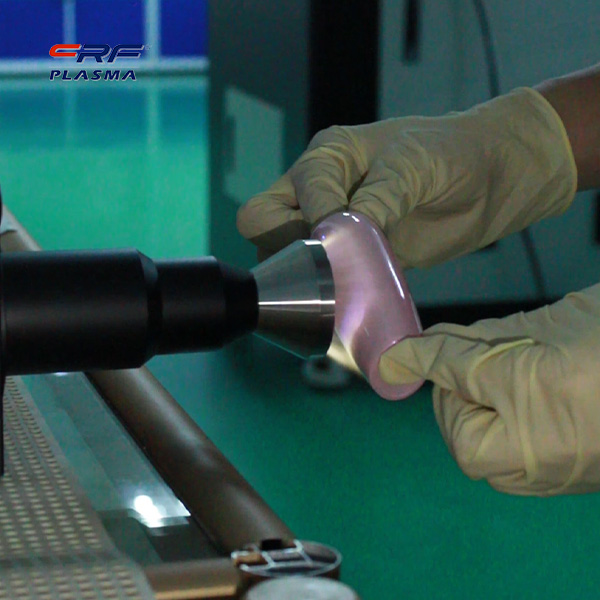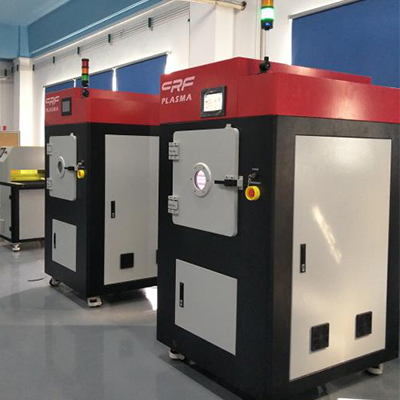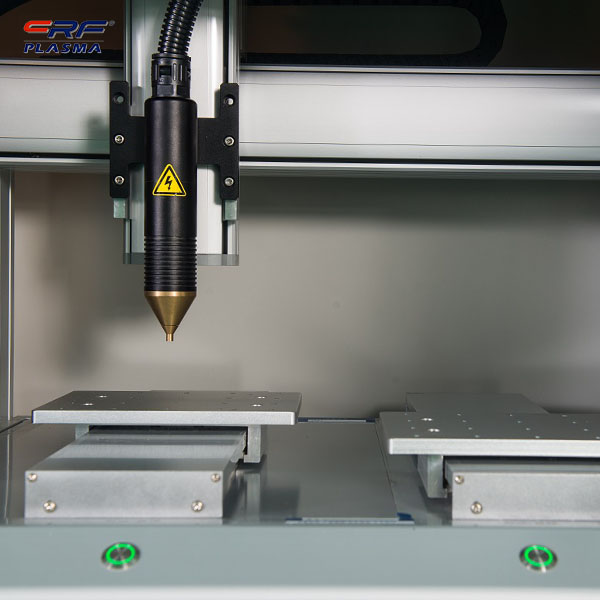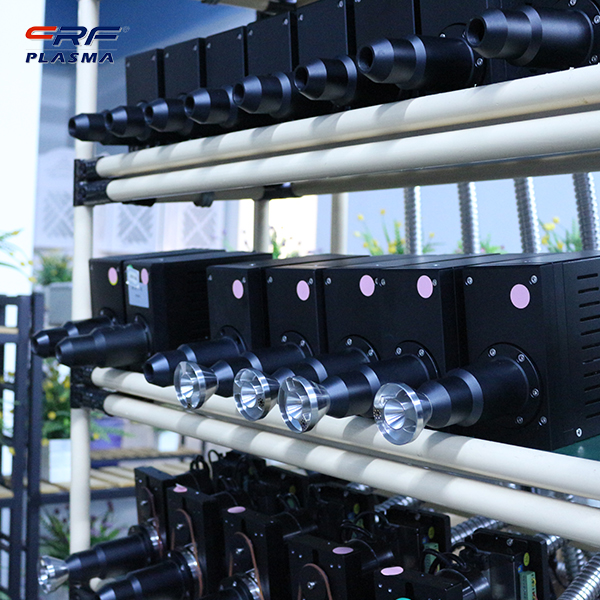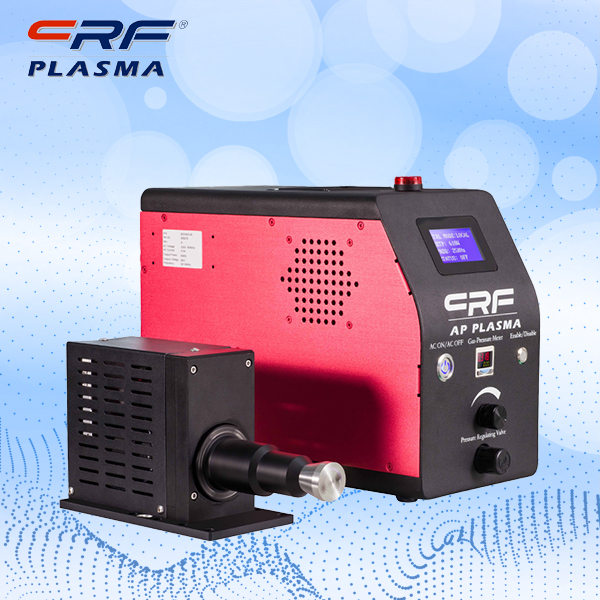
Welcome to Shenzhen Sing Fung Intelligent Manufacturing Co., Ltd.
E-mail:shaobo@sfi-crf.com
Research on the reasons for the enhancement of Raman scattering fluorescence of diamond by plasma treatment
- Categories:Industry News
- Author:Plasma cleaning machine-CRF plasma plasma equipment-plasma surface treatment machine manufacturer-chengfeng intelligent manufacturing
- Origin:
- Time of issue:2022-01-23
- Views:
(Summary description)Research on the reasons for the enhancement of Raman scattering fluorescence of diamond by plasma treatment: Fluorescent labeling is a very effective detection method for biomedical biosensing, material science, etc. Traditional organic fluorescent dye molecules such as rhodamine, fluorescein, acridine, and cyanine are prone to agglomeration (micron scale) and are not easy to enter cells. Fluorescein-based labels are prone to energy transfer with similar species, and the fluorescence signal decreases as the labeling amount increases, resulting in self-quenching. Diamond is both fluorescent and has no photobleaching phenomenon, high biocompatibility, non-toxicity, large specific surface area, and is easier to combine with antibodies to form fluorescent markers for targeted labeling. It is widely used in DNA nondestructive testing and immunoassays. . Integrate green fluorescent diamond nanoparticles with immune cell complexes to achieve labeling with different dyes into living cells. The nanodiamonds are attached to proteins, and the nanodiamond structures are self-organized to form a ring-shaped structure quantum, which becomes a tool for observing and understanding cells. However, the existing diamond fluorescence detection is not enough to meet all detection requirements, and it is necessary to further expand its application range by increasing the fluorescence intensity. Under the combined action of electromagnetic field enhancement and chemical enhancement, the total enhancement factor of the dye molecule is in the range of 103~104, and the molecule forms a "hot spot" in the gap, and the surface-enhanced Raman scattering and fluorescence spectrum of the dye molecule are detected. The concentration of the molecule is 10-1mol/L, which is expected to be used for the detection of biological single molecules. Photoluminescence spectra of metal surfaces using metal band theory. Compared with the plasmon resonance technology, the plasmon resonance technology is more efficient, simple and fast by simulating the increase of the distance between the fluorescent molecules by the nano-antenna array in the shape of a top triangle. Using plasmon resonance technology to enhance the fluorescence intensity of diamond nanoparticles, combining diamond nanoparticles with colloidal gold with stable performance, the fluorescence emission intensity of diamond distributed near the colloidal gold is greatly increased compared with the free state fluorescence emission intensity. The reasons for the enhanced Raman scattering and fluorescence of diamond may be: on the one hand, colloidal Au has a large specific surface area, free electrons in the particles are concentrated on the surface of the particles, and the excitation light interacts with them to form a light wave electromagnetic field on the surface of the Au particles. When the frequency of the electromagnetic field of the light wave is the same as the vibration frequency of the free electrons, the free electrons oscillate collectively, forming a strong local electric field near the metal surface, which accelerates the diamond in the excited state to release photons, thereby enhancing the fluorescence intensity of the diamond. On the other hand, from the perspective of energy transfer, when the free electrons in the metal interact with the fluorescent molecules in the excited state, the fluorescent molecules will quickly transfer energy to the free electrons. These transferred energies are released at a higher frequency than fluorescent molecules in free space, and thus, an enhancement of diamond fluorescence can be seen. The fluorescent molecules in the excited state transfer energy to the metal through the relaxation process to form plasma, and the fluorescence emitted by the fluorescent molecules without relaxation will induce these plasmas to generate radiation consistent with the radiation wavelength of the fluorescent molecules, thereby increasing the The fluorescence intensity. The fluorescence of diamond is enhanced by the interaction of the plasma formed by diamond nanoparticles and Au particles. As the mass fraction of Au increases gradually, the fluorescence intensity of diamond also increases accordingly. Plasma oscillation enhances the local electric field, accelerates the photon rate of diamond, and the energy transfer between diamond and Au, and the plasma radiation induced by fluorescent molecules are the reasons for the enhanced fluorescence of diamond.
Research on the reasons for the enhancement of Raman scattering fluorescence of diamond by plasma treatment
(Summary description)Research on the reasons for the enhancement of Raman scattering fluorescence of diamond by plasma treatment:
Fluorescent labeling is a very effective detection method for biomedical biosensing, material science, etc. Traditional organic fluorescent dye molecules such as rhodamine, fluorescein, acridine, and cyanine are prone to agglomeration (micron scale) and are not easy to enter cells. Fluorescein-based labels are prone to energy transfer with similar species, and the fluorescence signal decreases as the labeling amount increases, resulting in self-quenching.
Diamond is both fluorescent and has no photobleaching phenomenon, high biocompatibility, non-toxicity, large specific surface area, and is easier to combine with antibodies to form fluorescent markers for targeted labeling. It is widely used in DNA nondestructive testing and immunoassays. .
Integrate green fluorescent diamond nanoparticles with immune cell complexes to achieve labeling with different dyes into living cells. The nanodiamonds are attached to proteins, and the nanodiamond structures are self-organized to form a ring-shaped structure quantum, which becomes a tool for observing and understanding cells. However, the existing diamond fluorescence detection is not enough to meet all detection requirements, and it is necessary to further expand its application range by increasing the fluorescence intensity.
Under the combined action of electromagnetic field enhancement and chemical enhancement, the total enhancement factor of the dye molecule is in the range of 103~104, and the molecule forms a "hot spot" in the gap, and the surface-enhanced Raman scattering and fluorescence spectrum of the dye molecule are detected. The concentration of the molecule is 10-1mol/L, which is expected to be used for the detection of biological single molecules. Photoluminescence spectra of metal surfaces using metal band theory. Compared with the plasmon resonance technology, the plasmon resonance technology is more efficient, simple and fast by simulating the increase of the distance between the fluorescent molecules by the nano-antenna array in the shape of a top triangle.
Using plasmon resonance technology to enhance the fluorescence intensity of diamond nanoparticles, combining diamond nanoparticles with colloidal gold with stable performance, the fluorescence emission intensity of diamond distributed near the colloidal gold is greatly increased compared with the free state fluorescence emission intensity. The reasons for the enhanced Raman scattering and fluorescence of diamond may be: on the one hand, colloidal Au has a large specific surface area, free electrons in the particles are concentrated on the surface of the particles, and the excitation light interacts with them to form a light wave electromagnetic field on the surface of the Au particles.
When the frequency of the electromagnetic field of the light wave is the same as the vibration frequency of the free electrons, the free electrons oscillate collectively, forming a strong local electric field near the metal surface, which accelerates the diamond in the excited state to release photons, thereby enhancing the fluorescence intensity of the diamond. On the other hand, from the perspective of energy transfer, when the free electrons in the metal interact with the fluorescent molecules in the excited state, the fluorescent molecules will quickly transfer energy to the free electrons. These transferred energies are released at a higher frequency than fluorescent molecules in free space, and thus, an enhancement of diamond fluorescence can be seen.
The fluorescent molecules in the excited state transfer energy to the metal through the relaxation process to form plasma, and the fluorescence emitted by the fluorescent molecules without relaxation will induce these plasmas to generate radiation consistent with the radiation wavelength of the fluorescent molecules, thereby increasing the The fluorescence intensity. The fluorescence of diamond is enhanced by the interaction of the plasma formed by diamond nanoparticles and Au particles. As the mass fraction of Au increases gradually, the fluorescence intensity of diamond also increases accordingly. Plasma oscillation enhances the local electric field, accelerates the photon rate of diamond, and the energy transfer between diamond and Au, and the plasma radiation induced by fluorescent molecules are the reasons for the enhanced fluorescence of diamond.
- Categories:Industry News
- Author:Plasma cleaning machine-CRF plasma plasma equipment-plasma surface treatment machine manufacturer-chengfeng intelligent manufacturing
- Origin:
- Time of issue:2022-01-23 21:48
- Views:
Research on the reasons for the enhancement of Raman scattering fluorescence of diamond by plasma treatment:
Fluorescent labeling is a very effective detection method for biomedical biosensing, material science, etc. Traditional organic fluorescent dye molecules such as rhodamine, fluorescein, acridine, and cyanine are prone to agglomeration (micron scale) and are not easy to enter cells. Fluorescein-based labels are prone to energy transfer with similar species, and the fluorescence signal decreases as the labeling amount increases, resulting in self-quenching.
Diamond is both fluorescent and has no photobleaching phenomenon, high biocompatibility, non-toxicity, large specific surface area, and is easier to combine with antibodies to form fluorescent markers for targeted labeling. It is widely used in DNA nondestructive testing and immunoassays. .
Integrate green fluorescent diamond nanoparticles with immune cell complexes to achieve labeling with different dyes into living cells. The nanodiamonds are attached to proteins, and the nanodiamond structures are self-organized to form a ring-shaped structure quantum, which becomes a tool for observing and understanding cells. However, the existing diamond fluorescence detection is not enough to meet all detection requirements, and it is necessary to further expand its application range by increasing the fluorescence intensity.
 Under the combined action of electromagnetic field enhancement and chemical enhancement, the total enhancement factor of the dye molecule is in the range of 103~104, and the molecule forms a "hot spot" in the gap, and the surface-enhanced Raman scattering and fluorescence spectrum of the dye molecule are detected. The concentration of the molecule is 10-1mol/L, which is expected to be used for the detection of biological single molecules. Photoluminescence spectra of metal surfaces using metal band theory. Compared with the plasmon resonance technology, the plasmon resonance technology is more efficient, simple and fast by simulating the increase of the distance between the fluorescent molecules by the nano-antenna array in the shape of a top triangle.
Under the combined action of electromagnetic field enhancement and chemical enhancement, the total enhancement factor of the dye molecule is in the range of 103~104, and the molecule forms a "hot spot" in the gap, and the surface-enhanced Raman scattering and fluorescence spectrum of the dye molecule are detected. The concentration of the molecule is 10-1mol/L, which is expected to be used for the detection of biological single molecules. Photoluminescence spectra of metal surfaces using metal band theory. Compared with the plasmon resonance technology, the plasmon resonance technology is more efficient, simple and fast by simulating the increase of the distance between the fluorescent molecules by the nano-antenna array in the shape of a top triangle.
Using plasmon resonance technology to enhance the fluorescence intensity of diamond nanoparticles, combining diamond nanoparticles with colloidal gold with stable performance, the fluorescence emission intensity of diamond distributed near the colloidal gold is greatly increased compared with the free state fluorescence emission intensity. The reasons for the enhanced Raman scattering and fluorescence of diamond may be: on the one hand, colloidal Au has a large specific surface area, free electrons in the particles are concentrated on the surface of the particles, and the excitation light interacts with them to form a light wave electromagnetic field on the surface of the Au particles.
When the frequency of the electromagnetic field of the light wave is the same as the vibration frequency of the free electrons, the free electrons oscillate collectively, forming a strong local electric field near the metal surface, which accelerates the diamond in the excited state to release photons, thereby enhancing the fluorescence intensity of the diamond. On the other hand, from the perspective of energy transfer, when the free electrons in the metal interact with the fluorescent molecules in the excited state, the fluorescent molecules will quickly transfer energy to the free electrons. These transferred energies are released at a higher frequency than fluorescent molecules in free space, and thus, an enhancement of diamond fluorescence can be seen.
The fluorescent molecules in the excited state transfer energy to the metal through the relaxation process to form plasma, and the fluorescence emitted by the fluorescent molecules without relaxation will induce these plasmas to generate radiation consistent with the radiation wavelength of the fluorescent molecules, thereby increasing the The fluorescence intensity. The fluorescence of diamond is enhanced by the interaction of the plasma formed by diamond nanoparticles and Au particles. As the mass fraction of Au increases gradually, the fluorescence intensity of diamond also increases accordingly. Plasma oscillation enhances the local electric field, accelerates the photon rate of diamond, and the energy transfer between diamond and Au, and the plasma radiation induced by fluorescent molecules are the reasons for the enhanced fluorescence of diamond.
Scan the QR code to read on your phone

TEL:0755-3367 3020 / 0755-3367 3019

E-mail:sales-sfi@sfi-crf.com

ADD:Mabao Industrial Zone, Huangpu, Baoan District, Shenzhen




